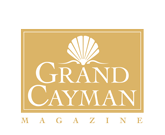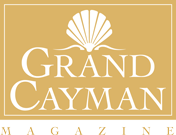When accountant Michael Pilling was asked by a work colleague to help a group called Friends of the Library in its fundraising efforts for the construction of a new library building in George Town, it was an easy sell for the avid reader.

The subsequent efforts of this group, headed by Jackie Smith, led to the entire 50 percent private sector contribution for the library refurbishment being secured from Maples law firm.
“The Maples Wing was opened in 2009 and has transformed the library service in George Town,” says Michael.
Nine years later, now-retired Michael is still an active member of Friends of the Library, a private sector group of individuals formed to support the activities of the library service and which builds on a strong culture of volunteerism at the library.
“Indeed, after its establishment in a room over the town jail in 1920, it was not until 1980 that a full-time professional librarian was appointed,” explains Michael. “The Friends group continues this tradition by involvement in activities that support and enhance the functions of the library service island-wide. This includes fundraising for items that fall outside the government budget.”
The library has always been an important building in George Town, providing traditional library services over the decades, as well as being host to a range of activities. These activities have recently been greatly enhanced by a cooperative effort with the Cayman Arts Festival which has led to the installation of a concert-quality grand piano in the building. This will form the basis for an ongoing series of events and performances showcasing local and visiting artists in music, poetry and literature.
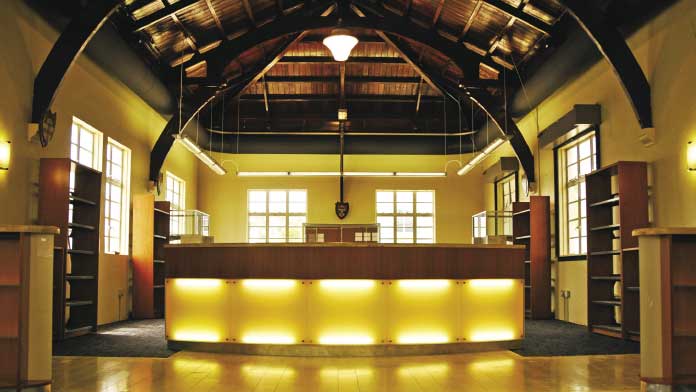
Library shields
The 80-year-old building has numerous intriguing design aspects, and while many people may be familiar with the unique library roof, designed by Captain Rayal Bodden along the lines of an inverted ship’s hull, they may be less familiar with the eight university shields which lie on corbels at the lower end of the braces supporting the roof’s hammer-beams.
The shields were removed temporarily while refurbishment work took place, and Michael’s interest was peaked. As part of the Friends of the Library, he has since written a guide to these heraldic shields which are steeped in history.
“Since no one seemed to know much about the shields, I took on the job of trying to find out. Discovering the identity of the individual shields was relatively easy as, perhaps unsurprisingly, they represent six of the seven “old” universities in the United Kingdom and Ireland, together with two relative newcomers, Wales and London,” he explains. “However, once you step into the arcane world of heraldry and its bizarre Norman French vocabulary, things can get quite complicated. The stories and legends that lie behind the imagery of the shields are fascinating in themselves and throw an intriguing light on the sometimes less than salubrious history of these now respectable institutions.”
The shield guide being compiled by Michael will be available in the library and will form part of the materials available to give to people touring the old library building in future. There will also be a copy in the Cayman Islands National Archives.
Here is a glimpse of a few of the shields featured in the brochure, with a snippet of the history behind the university and the shield components themselves.
Cambridge University (1209)
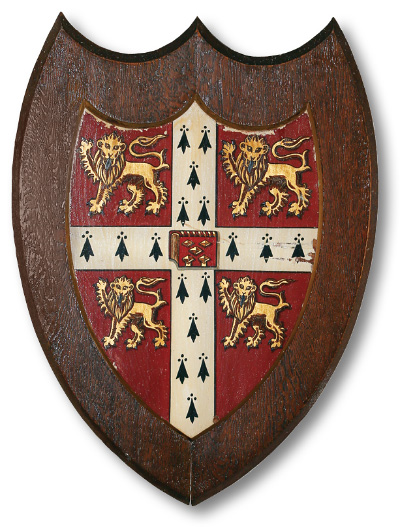 By the late 12th century, the Cambridge region of England already had a scholarly and ecclesiastical reputation, due to monks from the nearby bishopric church of Ely. This came in useful when in 1209 a group of scholars fled the university at Oxford after two scholars were summarily hanged by authorities in response to the death of a townswoman. The resulting university at Cambridge was granted a royal charter by King Henry III in 1231, making it the second-oldest university in the English-speaking world.
By the late 12th century, the Cambridge region of England already had a scholarly and ecclesiastical reputation, due to monks from the nearby bishopric church of Ely. This came in useful when in 1209 a group of scholars fled the university at Oxford after two scholars were summarily hanged by authorities in response to the death of a townswoman. The resulting university at Cambridge was granted a royal charter by King Henry III in 1231, making it the second-oldest university in the English-speaking world.
Cambridge University boasts a multitude of distinguished alumni. As well as 15 prime ministers, nine monarchs, Oliver Cromwell and the current Prince of Wales, the university boasts three of the signatories to the United States Declaration of Independence. Alumni range from Isaac Newton, Charles Darwin, Alan Turing and Stephen Hawking in science, to John Milton, Lord Tennyson and William Thackeray in literature and in more recent times Ian McKellen, Emma Thompson, Tom Hiddleston and most of the cast of Monty Python’s Flying Circus.
The arms of the university reflect its royal patronage. On a red background is a white cross dotted with small black marks. This is the heraldic convention for the fur of the ermine (a type of weasel) which in medieval times was a luxury reserved for royalty. White is the color of the ermine’s fur in winter and the black marks are indicative of its black-tipped tail. In each of the shield’s four quarters is a lion, the symbol of royalty, in what in heraldic terms is known as the “passant guardant” attitude, that is, walking (“passant”) but with enough time to turn and take a good look at the viewer (“guardant”). Central to the arms is a book, representing learning. The book in the Cambridge shield is closed, but at least has open clasps, perhaps indicating that enlightenment is available to anyone who is willing to make the effort to open it.
Aberdeen University (1495)
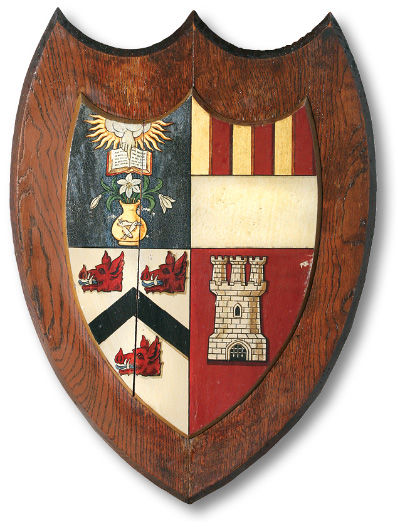 The first university in Aberdeen, King’s College, was founded in 1495 by William Elphinstone, Bishop of Aberdeen and Chancellor of Scotland. Following the Scottish Reformation in 1560, King’s College was purged of its Roman Catholic staff but in other respects was largely resistant to change. George Keith, the fifth Earl Marischal, was a moderniser within the college who in 1593 founded a second university in the city, Marischal College.
The first university in Aberdeen, King’s College, was founded in 1495 by William Elphinstone, Bishop of Aberdeen and Chancellor of Scotland. Following the Scottish Reformation in 1560, King’s College was purged of its Roman Catholic staff but in other respects was largely resistant to change. George Keith, the fifth Earl Marischal, was a moderniser within the college who in 1593 founded a second university in the city, Marischal College.
The two universities within the city developed along different lines and often clashed, sometimes in court, but also in brawls between students on the streets of Aberdeen. The rivalry was not ended until the two universities merged in 1860. From the founding of King’s University, the combined university is thus Scotland’s third oldest and the United Kingdom’s fifth oldest university.
Alumni include philosopher Alexander Bain as well as clergyman and educator James Blair, a founder of the College of William and Mary in Williamsburg, Virginia, and William Thornton, the physician, inventor and architect who designed the U.S. Capitol building. More recent alumni include Iain Glen the actor and politicians Alastair Darling and Tessa Jowell.
The arms of the university were officially granted in 1888, and incorporate elements from its founders and the city of Aberdeen. The shield is divided into four “quarters,” of which the first (top left) is a variation of the old arms of the city of Aberdeen (the “boughpot” containing lilies and decorated with entwined salmon) with the addition of an open book being handed down from above amid the rays of the sun, presumably a suggestion of the divine inspiration for learning. The second quarter (top right) shows the arms of Keith, Earl Marischal, founder of Marischal College. The third quarter (bottom left) shows the arms of Bishop Elphinstone, founder of King’s College and the fourth quarter (bottom right) shows a single tower from the three which appear in current arms of the City of Aberdeen.
Trinity College Dublin (1592)
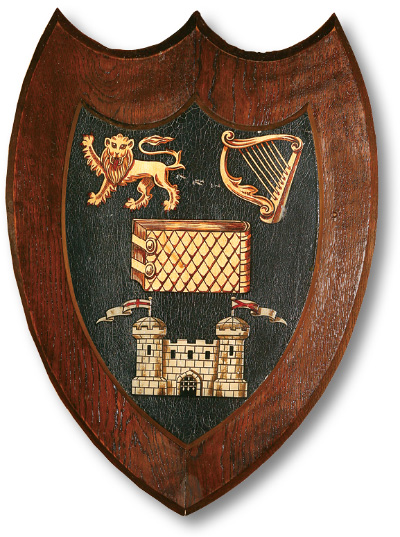 Founded in 1592 in the reign of Elizabeth I of England, Trinity College (officially the College of the Holy and Undivided Trinity of Queen Elizabeth near Dublin) is the sole constituent college of the University of Dublin. Established outside the Dublin city walls in the buildings of the outlawed Catholic Augustinian Priory of All Hallows, Trinity College was set up in part to consolidate the rule of the Tudor monarchy in Ireland, and as a result was seen as the university of the so-called “Protestant Ascendancy” for much of its history.
Founded in 1592 in the reign of Elizabeth I of England, Trinity College (officially the College of the Holy and Undivided Trinity of Queen Elizabeth near Dublin) is the sole constituent college of the University of Dublin. Established outside the Dublin city walls in the buildings of the outlawed Catholic Augustinian Priory of All Hallows, Trinity College was set up in part to consolidate the rule of the Tudor monarchy in Ireland, and as a result was seen as the university of the so-called “Protestant Ascendancy” for much of its history.
The history of the college reflects the political and religious turmoil of Ireland. Catholics were not allowed to apply for admission until 1793 and certain other restrictions on membership of the college remained until 1873. Ironically, uneasy at the relaxation of restrictions at what they perceived as a Protestant-dominated institution, in 1871 the Catholic bishops of Ireland forbade adherents of the Catholic Church from attending Trinity College without permission, a ban which lasted until 1970.
Alumni of the college include many political and literary figures, such as Wolfe Tone, Jonathan Swift, Samuel Beckett, Oliver Goldsmith and Oscar Wilde, as well as three former Presidents of Ireland.
The arms of Trinity College, granted in 1901, reflect its historical connections. The shield’s background is royal blue, which was the old national color of Ireland, green not making its appearance until the end of the eighteenth century. In the center of the shield is a closed book, although, as with Cambridge, the clasps are open. Above to the left is a lion, symbol of royalty, in a walking (“passant”) attitude. To the right we find the harp, the symbol of Ireland. At the base of the shield a castle “with two towers domed” is a link to the castles on the Dublin City coat of arms. The banner flying from the left tower is the English flag, bearing St. George’s Cross. That on the right bears the red saltire (diagonal cross) of the Fitzgeralds, an influential dynasty that has played a major role in Irish history. Their arms were later elevated to the rank of a national emblem, and when the kingdoms of Ireland and Great Britain were joined, the “St. Patrick’s Cross” (as it became known) was added to the Union Jack, where it remains to this day.
The reproduction of the shield for our library allowed for some poetic license. Our book is compressed, and the clasps closed, whereas in the official version they are open. The lion at the top left on our shield politely turns his head towards the viewer, adopting the “passant guardant” attitude. The harp in the official version bears the outline of a shamrock, but this is omitted on ours. Finally, the banners on our shield have been given fanciful long tapering ends, absent from the official version.
University of London (1836)
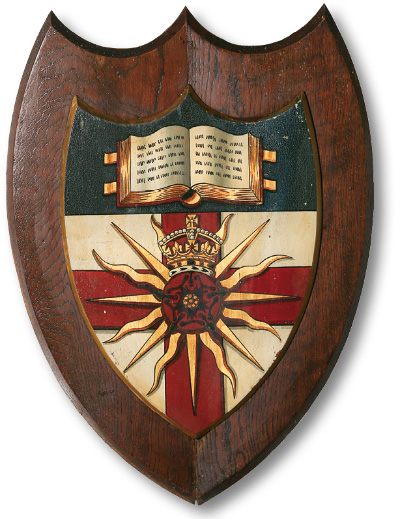 University College London (UCL) was founded under the name “London University” in 1826 as a secular alternative to the “ancient” religious universities of Oxford and Cambridge, which then still refused admission to non-Anglicans. In response to the theological controversy surrounding the establishment of the strictly secular UCL, King’s College London (KCL) was founded in 1829 under royal patronage to reassert the educational values of the establishment. The present form of the University of London was established by royal charter in 1836 and UCL and KCL later combined with other colleges and institutions in a federal structure. The university continued as a progressive force when in 1878 it became the first university in the United Kingdom to admit women.
University College London (UCL) was founded under the name “London University” in 1826 as a secular alternative to the “ancient” religious universities of Oxford and Cambridge, which then still refused admission to non-Anglicans. In response to the theological controversy surrounding the establishment of the strictly secular UCL, King’s College London (KCL) was founded in 1829 under royal patronage to reassert the educational values of the establishment. The present form of the University of London was established by royal charter in 1836 and UCL and KCL later combined with other colleges and institutions in a federal structure. The university continued as a progressive force when in 1878 it became the first university in the United Kingdom to admit women.
As of 2015, the university boasted two million alumni across the world including 12 monarchs or royalty, 52 presidents or prime ministers, 84 Nobel laureates, six Grammy winners and two Oscar winners. Notable political alumni are Junichiro Koizumi, Aung San Suu Kyi, Ramsay MacDonald, Desmond Tutu, Nelson Mandela, John F. Kennedy, and Mahatma Gandhi.
Staff and students, past and present, have contributed to important scientific advances, including the discovery of vaccines by Edward Jenner and Henry Gray (author of Gray’s Anatomy). Vital progress was made by University of London people in the following fields: discovery of DNA structure (Francis Crick, Maurice Wilkins and Rosalind Franklin); invention of modern electronic computers (Tommy Flowers); discovery of penicillin (Alexander Fleming and Ernest Chain); development of X-Ray technology (William Henry Bragg and Charles Glover Barkla); development of antiseptics (Joseph Lister); development of fiber optics (Charles K. Kao); and invention of the telephone (Alexander Graham Bell).
In the arts, culture and literature the university has produced many notable figures. Writers include Malcolm Bradbury, G. K. Chesterton, H. G. Wells, Thomas Hardy, Arthur C. Clarke and J.G. Ballard. Outstanding musicians include conductor Sir Simon Rattle, soprano Felicity Lott, both members of Gilbert and Sullivan, Mick Jagger, Elton John, and members of Coldplay, The Velvet Underground, Blur, Iron Maiden, Placebo, The Libertines, and Queen.
The arms of the University depict a cross of St. George upon which there is a Tudor rose surrounded by rays and surmounted by a crown, alluding to past and present royal patronage. The blue band along the top of the shield displays the familiar open book. As with most of the shields in our library, our version differs somewhat from the “official” version and has more gilt on its book and a more elaborate crown. The main difference is in the amount of “detailing” around the Tudor rose. In heraldic terms the rose is “irradiated,” in other words, that it is emitting rays of light. The official shield has fairly modest rays, while our rays surround the rose a bit like a golden octopus (with fifteen tentacles).
University of Wales (1893)
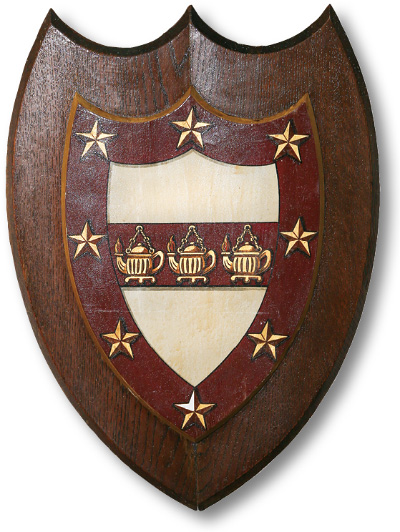 The University of Wales was established in 1893 as a federal university with three foundation colleges: University College Wales (now Aberystwyth University), which had been founded in 1872, University College North Wales (now Bangor University) and University College South Wales and Monmouthshire (now Cardiff University), both founded in 1881. In 2007, the University of Wales changed from a federal structure to a confederal one and many of the constituent colleges became independent universities. Following a number of controversies in the late 2000s involving overseas affiliates and student visas, a decision was made to abolish the university as it then existed.
The University of Wales was established in 1893 as a federal university with three foundation colleges: University College Wales (now Aberystwyth University), which had been founded in 1872, University College North Wales (now Bangor University) and University College South Wales and Monmouthshire (now Cardiff University), both founded in 1881. In 2007, the University of Wales changed from a federal structure to a confederal one and many of the constituent colleges became independent universities. Following a number of controversies in the late 2000s involving overseas affiliates and student visas, a decision was made to abolish the university as it then existed.
Alumni of the University of Wales include actress Rachel Roberts, broadcaster Huw Edwards, Plaid Cymru party leader Leanne Wood, rugby player Gareth Davies and contemporary composer William Mathias.
The shield of the university displays three medieval lamps in the central band, signifying the original three constituent colleges. The eight “mullets” or stars around the edge of the shield represent the “elements” which made up the original University Court, although information is scarce as to what exactly these “elements” comprised. Alone among the shields on display in the library, this one does not display a book as a symbol of learning. Perhaps a lamp was felt to be more appropriate, as indicative of the desire to find learning. However, when one looks at the crest which accompanies the shield in the official coat of arms, there we find a red Welsh dragon standing with one claw resting nonchalantly on an open book, which is inscribed with the words “Goreu Awen Gwirionedd.” These are the words of the University Motto, which can be translated as “The Best Inspiration is Truth.”
















